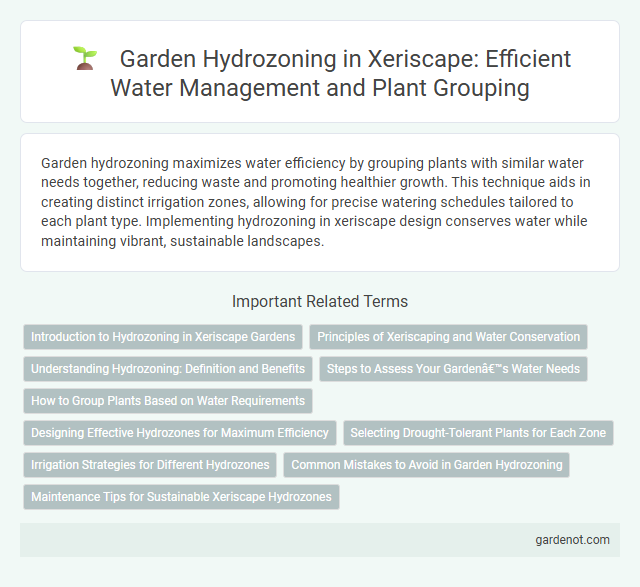Garden hydrozoning maximizes water efficiency by grouping plants with similar water needs together, reducing waste and promoting healthier growth. This technique aids in creating distinct irrigation zones, allowing for precise watering schedules tailored to each plant type. Implementing hydrozoning in xeriscape design conserves water while maintaining vibrant, sustainable landscapes.
Introduction to Hydrozoning in Xeriscape Gardens
Hydrozoning in xeriscape gardens involves grouping plants with similar water needs to optimize irrigation efficiency and conserve water. By creating distinct zones based on plant drought tolerance and water requirements, gardeners reduce water waste and promote healthier plant growth. This method is fundamental in xeriscaping because it aligns irrigation practices with the natural water usage of each plant group.
Principles of Xeriscaping and Water Conservation
Garden hydrozoning in xeriscaping involves grouping plants with similar water needs to optimize irrigation efficiency and conserve water. This principle supports xeriscaping's core goals by reducing water runoff, minimizing evaporation, and promoting sustainable landscape management. Implementing hydrozones ensures tailored watering schedules, significantly decreasing overall water consumption in drought-prone or water-restricted areas.
Understanding Hydrozoning: Definition and Benefits
Hydrozoning in xeriscape gardening involves grouping plants with similar water needs to optimize irrigation efficiency and conserve water. This method reduces water waste by tailoring irrigation schedules to the specific requirements of each zone, enhancing plant health and promoting sustainable landscaping. Effective hydrozoning supports drought-tolerant gardening practices by minimizing overwatering and ensuring resource conservation.
Steps to Assess Your Garden’s Water Needs
Assess your garden's water needs by first identifying plant types and grouping them according to their water requirements, separating drought-tolerant species from those needing more moisture. Measure soil moisture levels across different zones using a soil moisture meter to determine irrigation frequency and duration for each section. Finally, analyze sun exposure and microclimates within the garden to adjust watering schedules, ensuring efficient water use tailored to specific plant and environmental conditions.
How to Group Plants Based on Water Requirements
Group plants in xeriscape gardens by categorizing them into hydrozones, which are areas with similar water needs. Place high-water-use plants together near irrigation sources, while drought-tolerant species should be clustered in low-water-use zones to maximize water efficiency. This strategic hydrozoning reduces water waste and promotes sustainable landscape management.
Designing Effective Hydrozones for Maximum Efficiency
Designing effective hydrozones in xeriscape gardens involves grouping plants with similar water requirements to optimize irrigation and reduce water waste. Strategic placement of drought-tolerant species in low-water zones and moisture-loving plants in high-water zones enhances landscape efficiency. Proper hydrozoning maximizes resource conservation while maintaining plant health and aesthetic appeal.
Selecting Drought-Tolerant Plants for Each Zone
Garden hydrozoning involves grouping plants with similar water needs to maximize irrigation efficiency and conserve water. Selecting drought-tolerant plants like lavender, sedum, and agave for each zone reduces overall water consumption while maintaining plant health and landscape aesthetics. Proper hydrozoning with drought-resistant species supports sustainable xeriscape practices and enhances garden resilience during dry seasons.
Irrigation Strategies for Different Hydrozones
Garden hydrozoning involves grouping plants with similar water needs to optimize irrigation efficiency and conserve water in xeriscaping. Implementing irrigation strategies such as drip systems for low-water-use zones and targeted sprinklers for moderate-use zones ensures precise water delivery tailored to each hydrozone's requirements. This approach reduces water waste, promotes plant health, and supports sustainable landscaping practices.
Common Mistakes to Avoid in Garden Hydrozoning
Garden hydrozoning requires grouping plants with similar water needs to maximize irrigation efficiency and conserve water. Common mistakes to avoid include mixing high-water use plants with drought-tolerant species, which leads to overwatering and plant stress. Overlooking soil type variations and failing to adjust irrigation schedules accordingly can also result in poor plant health and water waste.
Maintenance Tips for Sustainable Xeriscape Hydrozones
Grouping plants with similar water needs into distinct hydrozones reduces water waste and simplifies irrigation scheduling in xeriscape gardens. Regularly inspect irrigation systems for leaks and adjust emitters seasonally to align with changing plant water requirements. Mulching hydrozones conserves soil moisture, suppresses weeds, and promotes healthier root systems, enhancing overall landscape sustainability.
Garden hydrozoning Infographic

 gardenot.com
gardenot.com